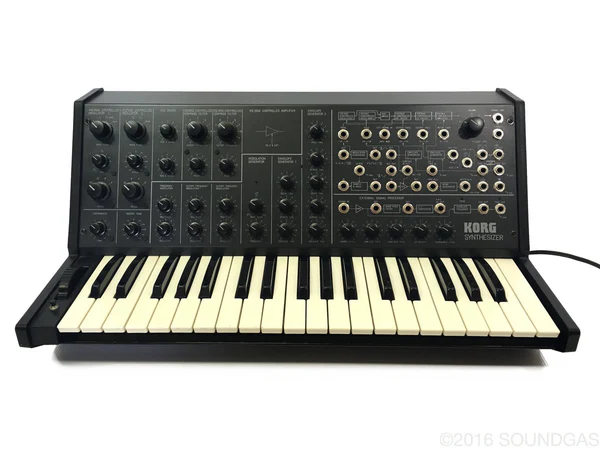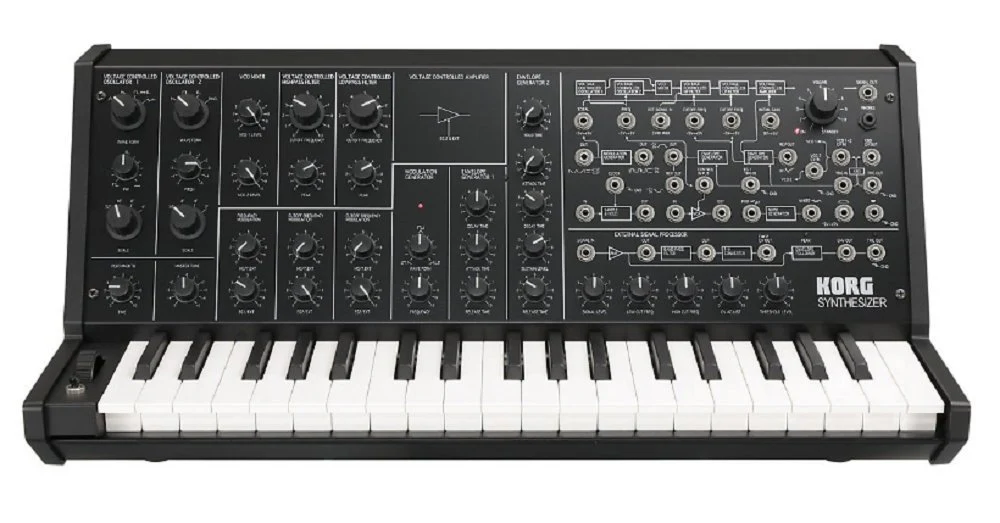Korg MS-20
Electronic Instruments
America
Between 1901 and present
Video
The Korg MS-20 is a monophonic analog synthesizer renowned for its semi-modular design and iconic sound. Released in 1978 by Korg, it quickly gained popularity among musicians, sound designers, and producers due to its raw, aggressive tone and flexible patching capabilities. The MS-20 features two oscillators (VCOs), a resonant low-pass and high-pass filter, an external signal processor (ESP), and a patch bay that allows for creative sound shaping.
As a semi-modular synthesizer, the MS-20 does not require patching to function, but its patch bay expands its sonic possibilities. It has a 37-note keyboard and an intuitive interface, making it a versatile tool for various genres of music, including electronic, ambient, experimental, and industrial.
Types of the Korg MS-20
- Original Korg MS-20 (1978): The first model, known for its warm analog sound and powerful filters, which had a steep resonance and distinctive growl.
- MS-20 Mini (2013): A modern reissue that retained the original’s circuitry and character while being 86% the size, with MIDI and USB connectivity.
- MS-20 Kit (2014): A DIY (do-it-yourself) version allowing users to assemble the synth themselves, with both early and late filter revisions included.
- MS-20M (2015): A desktop module without a keyboard but with additional features like PWM (pulse-width modulation) and a frequency modulation switch.
- MS-20 FS (2020): A full-sized reissue of the original, available in multiple colors, staying true to the original design and sound.
History and Origin
Historically, the Korg MS-20 emerged during a pivotal moment in electronic music history on multiple continents during late twentieth-century Europe and North America. It was developed with an emphasis on cost-effectiveness while offering advanced features such as dual voltage-controlled oscillators (VCOs), two envelope generators, and an external signal processor (ESP). Despite initial slow adoption due to unfamiliarity with synthesis techniques at that time, it eventually found popularity among young producers who appreciated its raw sound quality.
The Korg MS-20 was developed in the late 1970s when synthesizers were becoming increasingly popular but were still expensive and complex. Korg sought to create an affordable yet powerful synthesizer that could be accessible to both professionals and beginners. Released in 1978, the MS-20 quickly became a favorite among electronic musicians due to its flexibility, aggressive filter design, and affordability compared to other synthesizers of the era. The MS-20 was developed by Fumio Mieda, a key engineer at Korg, who designed its legendary high-pass and low-pass filters, often praised for their distinctive distortion and resonance. These filters made the MS-20 a sought-after synthesizer for those looking to create cutting-edge electronic music. The synth remained in production until 1983, after which it became a cult classic.
During the resurgence of interest in analog synthesizers in the early 2010s, Korg reissued the MS-20 in various forms, ensuring new generations of musicians could experience its unique sound and playability.
Features of the Korg MS-20
The Korg MS-20 is known for its impressive features that make it a unique synthesizer:
- Two Voltage-Controlled Oscillators (VCOs): Capable of producing sawtooth, triangle, pulse, and white noise waveforms.
- Self-Oscillating Filters: The high-pass and low-pass filters provide aggressive resonance, creating a signature distorted sound.
- External Signal Processor (ESP): Allows users to process external audio signals through the synth, enabling guitarists, vocalists, and other instrumentalists to use the MS-20 as an effects processor.
- Patch Bay: Offers expanded modulation possibilities, allowing creative routing of signals for unique sound design.
- Voltage-Controlled Amplifier (VCA): Shapes the output volume dynamically.
- Modulation Options: Includes sample & hold, envelope generators, and LFOs to create dynamic sound movement.
- Portamento: A glide function that smooths transitions between notes.
- MIDI/USB Connectivity (on modern versions): Enables integration with modern music production setups.
Music and Significance
The Korg MS-20 has played an essential role in the evolution of electronic music, inspiring artists across various genres. Its raw, powerful tone and versatile patching make it a favorite among musicians who seek unique soundscapes.
Use in Music Production
The MS-20 has been widely used in genres.
Artists like Aphex Twin and Daft Punk have used it for its gritty basslines and distorted leads. Bands like Nine Inch Nails have incorporated its aggressive tones into their music. The synthesizer’s modulating filters and patching capabilities allow for evolving sound textures. Artists like Depeche Mode have used it to add analog warmth to their songs.
Cultural and Historical Significance
The MS-20 has remained significant due to its accessibility, unique sound, and impact on synthesizer design. Unlike many synthesizers of its time, the MS-20 was relatively affordable, allowing more musicians to experiment with analog synthesis. Its semi-modular design influenced later modular and semi-modular synths, paving the way for modern sound design approaches.
The continued reissues by Korg demonstrate its enduring popularity, and it remains a staple in both professional studios and home setups. Whether in vintage form or as a modern reproduction, the MS-20 continues to inspire creativity in musicians worldwide.
FAQ
What materials are used in constructing a typical analog synthesizer like the KORG_MS?
Typical materials used include metal for casing components such as knobs and switches; printed circuit boards made from fiberglass reinforced epoxy laminate; transistors; diodes; resistors; capacitors; wires often insulated with PVC or Teflon coatings; potentiometers typically constructed from carbon film resistive elements mounted within plastic casings secured onto metal shafts. Additionally wooden panels may be used aesthetically.
How does construction affect sound quality?
Construction affects sound quality primarily through component selection—quality capacitors reduce noise levels while precise resistors maintain stability across temperature changes.[(Source: VintageSynth)]( https://vintage-synth-explorer.html)
What role does material choice play?
Material choice plays a crucial role by ensuring durability—metals provide robustness against wear—and maintaining electrical integrity over years without degradation affecting performance. Proper insulation prevents interference.
 Links
Links
References
Other Instrument
Categories



















